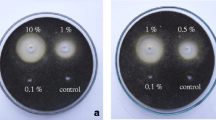Abstract
Zymoseptoria tritici, responsible for Septoria tritici blotch, is the most important pathogen of wheat. The control of this parasite relies mainly on synthetic fungicides, but their use is increasingly controversial and searching for alternative management strategies is encouraged. In this context, the biocontrol potential of crude methanolic extracts of eight extremophile plant species from Tunisia, including three xerophytes and five halophytes, against Z. tritici was assessed. Only the extract of Juncus maritimus rhizomes showed significant in vitro antifungal activity. In extremophile plants, the production of secondary metabolites is often influenced by abiotic conditions. Thus, we collected several samples of J. maritimus rhizomes at different vegetative stages, at different periods, and from different substrates to compare their antifungal activities. Our results suggest that the plant environment, especially the substrate of the soil, should be taken into account to identify great sources of natural antifungal products. From the most active sample, a 9,10-dehydrophenanthrene derivative, effusol, absent from other J. maritimus rhizomes extracts, was purified. This product showed a strong antifungal activity against the pathogen, with a minimal inhibitory concentration of 19 μg mL−1 and an half-maximal inhibitory concentration of 9.98 μg mL−1. This phenanthrene derivative could be a promising biocontrol molecule against Z. tritici.






Similar content being viewed by others
References
Awaad AS, Zain ME, Al Othman MR, Al-Dosary SK (2014) Phytochemical analysis and antimicrobial activity of medicinal plants against pathogenic microorganisms. Life Sci J 11:350–354
Baysal-Gurel F, Miller SA (2015) Management of powdery mildew in greenhouse tomato production with biorational products and fungicides. Sci Hortic 1069:179–184
Bhattacharyya J (1980) Structure of effusol: a new phenolic constituent from Juncus effusus. Experientia 36:27–28
Cheval P, Siah A, Bomble M et al (2017) Evolution of QoI resistance of the wheat pathogen Zymoseptoria tritici in Northern France. Crop Prot 92:131–133
Cowger C, Hoffer ME, Mundt CC (2000) Specific adaptation by Mycosphaerella graminicola to a resistant wheat cultivar. Plant Pathol 49:445–451
Dayan FE, Cantrell CL, Duke SO (2009) Natural products in crop protection. Bioorg Med Chem 17:4022–4034
Dow AI, Cline TA, Horning EV (1981) Salt tolerance studies on irrigated mint. Bulletin of Agriculture Research Center, Washington State University, Pullman 906: 11
El-Shamy AI, Abdel-Razek AF, Nassar MI (2015) Phytochemical review of Juncus L. genus (Fam. Juncaceae). Arab J Chem 8:614–623
Fisch H, Flick BH, Arditti J (1973) Structure and antifungal activity of hircinol, loroglossol and orchinol. Phytochemistry 12:437–441
Fones H, Gurr S (2015) The impact of Septoria tritici blotch disease on wheat: an EU perspective. Fungal Genet Biol 79:3–7
Ishiuchi K, Kosuge Y, Hamagami H et al (2015) Chemical constituents isolated from Juncus effusus induce cytotoxicity in HT22 cells. Nat Med 69:421–426
Jess S, Kildea S, Moody A, Rennick G, Murchie AK, Cooke LR (2014) European Union policy on pesticides: implications for agriculture in Ireland. Pest Manag Sci 70:1646–1654
Kovács A, Vasas A, Hohmann J (2008) Natural phenanthrenes and their biological activity. Phytochemistry 69:1084–1110
Ksouri R, Megdiche W, Debez A et al (2007) Salinity effects on polyphenol content and antioxidant activities in leaves of the halophyte Cakile maritime. Plant Physiol Biochem 45:244–249
Ksouri R, Ksouri WM, Jallali I et al (2012) Medicinal halophytes: potent source of health promoting biomolecules with medical, nutraceutical and food applications. Crit Rev Biotechnol 32:289–326
Maisuthisakul P, Suttajit M, Pongsawatmanit R (2007) Assessment of phenolic content and free radical scavenging capacity of some Thai indigenous plants. Food Chem 100:1409–1418
Olson S (2015) An analysis of the biopesticide market now and where it is going. Outlooks on Pest Management 26:203–206
Ponomarenko A, Goodwin SB, Kema GH (2011) Septoria tritici blotch (STB) of wheat. Plant Health Instructor. doi:10.1094/PHI-I-2011-0407-01
Ravensberg W (2015) Crop protection in 2030: towards a natural, efficient, safe and sustainable approach. International Symposium Swansea University 7–9 September 2015
Siah A, Deweer C, Morand E et al (2010) Azoxystrobin resistance of French Mycosphaerella graminicola strains assessed by four in vitro bioassays and by screening of G143A substitution. Crop Prot 29:737–743
Tóth B, Liktor-Busa E, Urbán E et al (2016) Antibacterial screening of Juncaceae species native to the Carpathian Basin against resistant strains and LC-MS investigation of phenanthrenes responsible for the effect. Fitoterapia 115:69–73
Wang YG, Wang YL, Zhai HF et al (2012) Phenanthrenes from Juncus effusus with anxiolytic and sedative activities. Nat Prod Res 26:1234–1239
Acknowledgement
This study was supported by an internal financial support from the Charles Viollette Institute. The authors wish to thank platforms of CUMA (University of Lille 2, Pr. J.F. Goossens) and LARMN (University of Lille 2, Pr. N. Azaroual) for access to equipment.
Author information
Authors and Affiliations
Corresponding author
Additional information
Responsible editor: Philippe Garrigues
Electronic supplementary material
ESM 1
(DOCX 15 kb).
Rights and permissions
About this article
Cite this article
Sahli, R., Rivière, C., Siah, A. et al. Biocontrol activity of effusol from the extremophile plant, Juncus maritimus, against the wheat pathogen Zymoseptoria tritici . Environ Sci Pollut Res 25, 29775–29783 (2018). https://doi.org/10.1007/s11356-017-9043-0
Received:
Accepted:
Published:
Issue Date:
DOI: https://doi.org/10.1007/s11356-017-9043-0




